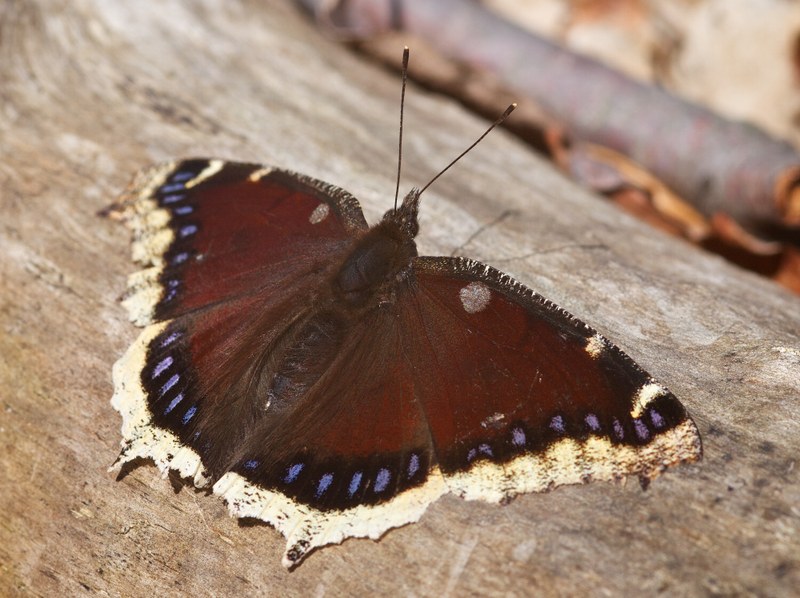Posted: November 22, 2021
IBC Education Specialist Heather Desorcie reports on how leaf litter benefits insects and larger ecosystems

Leaving leaf litter in place, rather than raking it all up, is an easy and effective way to support insects in your own backyards
Golden leaves drifted down from the trees, marking the arrival of autumn. In response, many people incorporated leaf raking or blowing into their fall landscaping, creating piles by the roadside. Others chose to leave their leaves where they landed, laying the groundwork for a hidden winter world in their yard.
In nature, leaves fall from deciduous trees and cover the forest floor. This layer is called leaf litter, and it is teeming with life. Microbes get to work, breaking down the organic matter into smaller and smaller pieces which can then be consumed and excreted by a number of organisms such as wood lice, millipedes, snails, fly larvae, and earthworms. This is called decomposition, where nitrogen is recycled from leaves back into the soil for plants to take up through their roots. Removing leaf litter eliminates this natural source of nutrients that moves its way through the entire food web.
Prior to decomposing, leaves serve as shelter for many insects throughout the cold winter months such as beetles (Coleoptera) and walking sticks (Phasmatodea). The Nine-spotted Ladybug (Coccinella novemnotata) overwinters as an adult beetle in a state called diapause, a type of dormancy that slows respiration and pauses development until spring. Walking sticks, on the other hand, spend the winter as an egg. In the fall, adult females perch on tree branches and drop their eggs onto the forest floor below. They remain in the leaf litter until spring, when they hatch as nymphs.
Some species of insects found in leaf litter are pollinators; animals that consume nectar and pollen and inadvertently move pollen from flower to flower, contributing to the reproduction of plants. The Hummingbird Clearwing (Hemaris thysbe), a species of sphynx moth, overwinters in leaf litter as a pupa. Sphinx moths are highly effective diurnal, or daytime, pollinators. Their long tongues and ability to feed while hovering allow them to access a greater variety of flowers. They are able to fly in colder temperatures, providing them with a longer daily feeding window.
Overwintering as a pupa is common. The Eastern Tiger Swallowtail (Papilio glaucus) is another example. However, some butterflies hibernate in leaf litter as adults, such as the Question Mark (Polygonia interrogationis), Mourning Cloak (Nymphalis antiopa), and Milbert’s Tortiseshell (Aglais milberti) butterflies. It should be noted that while many Lepidoptera species overwinter in Pennsylvania, they are not all considered pollinators. Some species lack functional mouthparts as adults, which prevents them from feeding at floral nectaries.


Left: The Mourning Cloak butterfly overwinters in leaf litter in the adult stage. Photo credit: David Marvin, Flickr under CC BY-NC-ND 2.0; Right: This beautiful Eastern Tiger Swallowtail requires leaf litter over the winter to pupate, before reaching the adult stage. Photo credit: Peter Miller, Flickrunder CC BY-NC-ND 2.0
If you have a goal of increasing biodiversity in your yard, ceasing to rake leaves is an easy and effective practice to adopt. Nurturing insect life under the leaves will support a wide variety of springtime plants and animals. Virtually all songbirds require insects, specifically caterpillars, to feed their young. Plants will grow in nutritious soil and receive pollination from butterflies and sphinx moths. You may even attract small amphibians such as toads and salamanders that live under moist leaves and eat insects.

Cecropia Moth (Hyalophora cecropia) spinning a cocoon with dried fall leaves. Photo credit: Moriah Spzara (used with permission)
To explore what lives under your leaves, all you need is a few simple tools and curiosity. A step-by-step guide can be found here. To learn more about how to create habitat for pollinators in your backyard, visit the Penn State Master Gardener’s Pollinator Garden Certification website. For more information about what lives underground, read Life in the Soil: A Guide for Naturalists and Gardeners by James B. Nardi.

